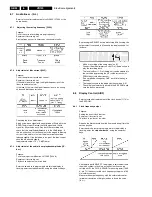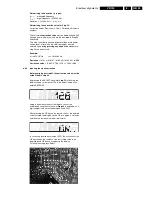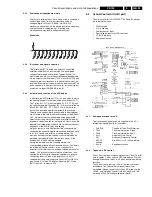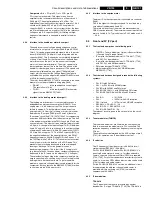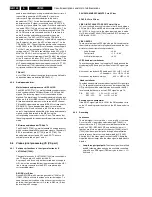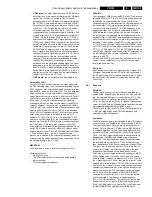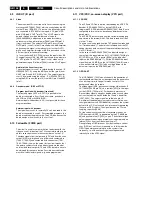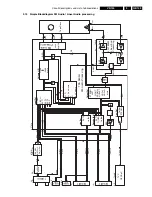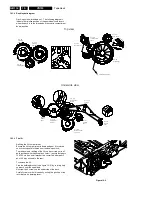
Circuit descriptions and List of abbreviations
GB 105
VR120
9.
9.7.4
Audio linear playback
During playback the switch [T7604, T7607] is controlled by
pin 99 and is closed. The playback signal from the head is
amplified in the equaliser stage (time constant between pin 1
and pin 3) and passed to pin 1. The resistor R3633 and the
capacitor C2619 determine the head resonance during
playback.
In long play mode the frequency characteristic is modified
using R3627, C2617 for playback.
The output of the playback amplifier (pin 1) is passed via the
filter R3632, C2623 to pin 100 where an electronic
potentiometer sets the playback level via the IIC bus.
Amplifier and head tolerances are compensated here. The
amplification can be compensated via software control (IIC
bus) in service mode.
9.7.5
Audio linear muting
The mute stage in the linear audio part on the IC LA71595
[7004-A] is controlled by the combination control line
MTA_CROT which is connected on pin 10 (VS part). The
mute stage is activated in that the CROT control signal
(square-wave pulse 1.7 Vss) is moved into the upper direct
voltage range ( > 2.2 V ).
9.8
Audio HiFi - for stereo units (AF part)
9.8.1
General
All audio input and output selection switches, and the hi-fi FM
audio signal processing, are located in the TDA9605 [7650].
This IC is controlled solely by the IIC bus. The carrier
frequencies and band pass filter for the FM audio part are
adjusted by the TDA9605 independently. This adjustment is
started via the IIC bus following a mains reset. The RMHI
signal is used as a reference for this [7650 Pin 41].
9.8.2
Audio I/O
The input and output selection switches are controlled
exclusively by the IIC bus. Audio signals coming from the
receiver part, the two scart sockets and the front sockets
pass via pins 2 to 9 to the two input selector switches which
select the relevant signals for the FM and the linear audio
part. The output selector switch for SCART 1 and SCART 2
(pins 16,17 and 19, 20) select the relevant signal sources,
independently from one another.
The RFAGC limits the maximum amplitude of the signal to
the AMCO modulator (pin 13) to prevent overmodulation.
9.8.3
Audio HiFi recording
The signal coming from the input selector switch (INPUT
SEL) reaches, via a level actuator (VOLUME L//R) and a low
pass filter (LPF), the NOISE REDUCTION block, which
compresses the dynamics during recording. The
compressed signal is passed to both FM modulators
(1.4MHz and 1.8MHz carrier frequencies). Both carriers are
added and pass to the FM audio head amplifier. Via the
recording / playback switch on the head amplifier, which is
switched using the control line RMHI, the FM signal reaches
the output (pin 35, pin 36, pin 37) on the FM audio processor
and then the audio heads via the rotating transformer. The
TRIA_ALM line forwards the size of both audio signals (1
VRMS = 2.68 VDC) to the AIO processor [7899-B]. This DC
level information is required during recording by the SCART
or front cinch socket to prevent overmodulation of the FM
carriers. When the audio signal levels are too high, they are
attenuated using the VOLUME controller via the I
2
C bus.
9.8.4
Audio HiFi playback
The FM signal from the audio heads goes via the rotating
transformer to the recording / playback switch (pin 35, pin 36,
pin 37) on the head amplifier. After amplification in the head
amplifier (66 dB), the FM signal reaches the HF-AGC
(Automatic Gain Control), where the tolerances of the tape,
the heads and the rotating transformer are balanced. Via the
two band pass filter and limiters, the FM signals reach the
PLL demodulators. Head change-over interference is
suppressed using SAMPLE & HOLD stages (triggered by the
RMHI signal). The demodulated signals are then expanded
into the NOISE REDUCTION stage. The hi-fi signals are then
available at the output selection switches. If there is no audio
FM on the tape during playback, the output selector switch is
switched over automatically from the IC to linear audio (input
pin 22). In playback mode the TRIA_ALM line supplies the
level of the FM envelope curve to the AIO processor [IC7899-
B]. This level information from the FM envelope curve is used
for the hi-fi tracking of the rotating FM audio heads to achieve
the best possible playback quality (typically: 3.5 VDC).
9.8.5
Interface to the audio linear
In recording mode, the input selection switch NORMAL SEL
in the TDA9605 [7650] selects the audio source for the linear
audio part in the signal electronics IC LA71595 [7004 - A] and
passes this signal to pin 21 (AMLR).
In stereo sets, the input selection switch on the signal
electronics IC LA71595 [7004-A] is always set to IN2 (pin 78).
During playback the AMLP signal passes from the linear
audio part in the signal electronics IC [7004-A] pin 96 to the
linear audio input on pin 22 on the TDA9605 [7650].
A: DC, 1 V/Div, 20ms/Div
0V
IC7004-B PIN10 CROT/MTA
71
MTA
MUTE
active
no MUTE
Summary of Contents for VR570
Page 12: ...Direction for use GB 12 VR120 3 3 Direction for use RT111 RT116 RT112 RT114 RT123 RT121 RT128 ...
Page 15: ...Direction for use GB 15 VR120 3 SAT VR870L VR870CC VR720 Set width 435 mm ...
Page 56: ...Service modes Repair tips GB 56 VR120 5 Engineer s remarks ...
Page 79: ...Circuit diagrams and PWB layouts Wiring diagram 79 VR120 7 7 16 Wiring Diagram Motherboard ...
Page 81: ...Circuit diagrams and PWB layouts Wiring diagram 81 VR120 7 Engineer s remarks ...
Page 82: ...82 VR120 7 Circuit diagrams and PWB layouts Wiring diagram Engineer s remarks ...
Page 83: ...Circuit diagrams and PWB layouts Wiring diagram 83 VR120 7 7 18 Mother board component side ...
Page 119: ...Tape deck GB 119 VR120 10 ...
Page 123: ...Tape deck GB 123 VR120 10 Engineer s remarks ...




